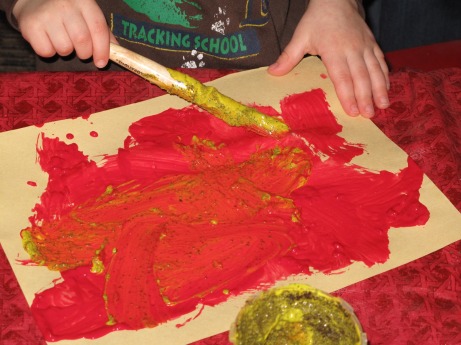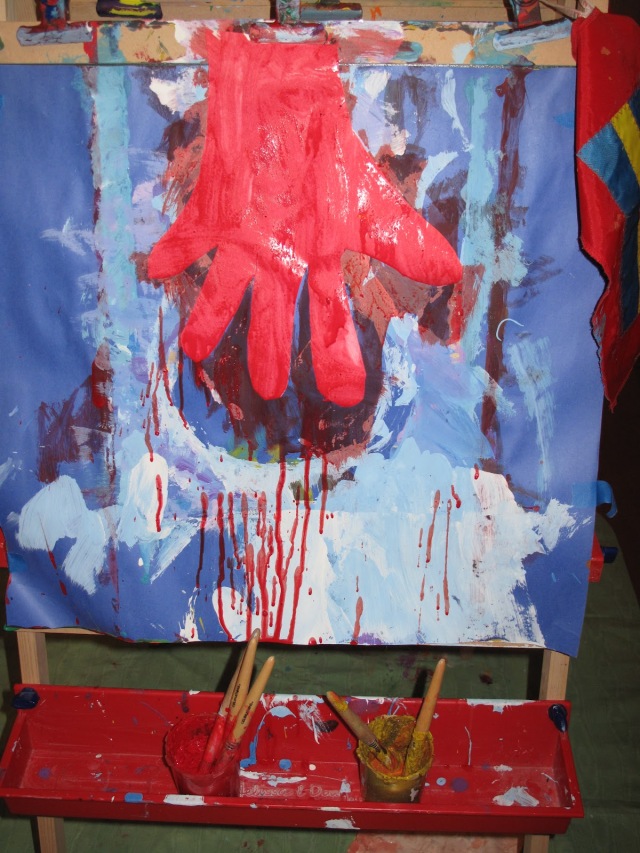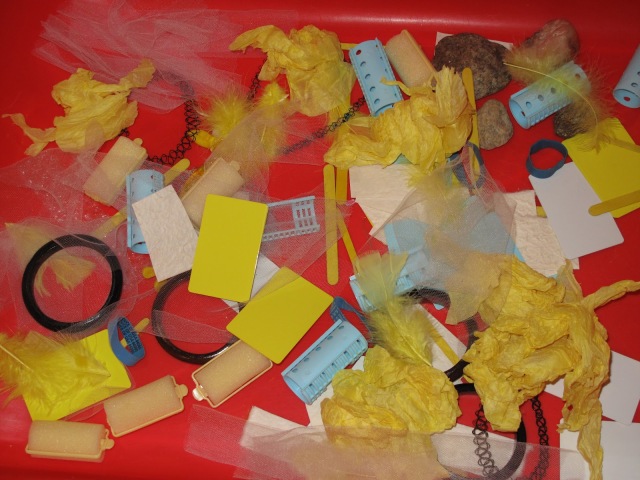Outdoor Discovery Time– I love connecting what we are learning to meaningful and real experiences outdoors. So when learning about the sense of touch, I love to my children on a “Finding Textures Walk”. In fact, I feel like I can relate most things that I am teaching about to a nature walk. What is fun about nature walks is there is always something new to discover, and it take no ‘prep work’ on the teacher’s part. Do our walks fail sometimes? Absolutely, but isn’t failing also a great life lesson?
For our “Finding Textures Walk” we used our hands to explore different objects in our surroundings. The language and expressions that children come up with for different objects is inspiring and humorous. Recording the children’s dialogue while they are exploring, and then revisiting that dialogue back at a group meeting is a wonderful way to reflect on their experiences.
What might you find on a texture walk? Crunchy snow, slick ice, sticky pine cones, rough and bumpy bark, smooth and paper-like bark, prickly pine needs, thorny bushes, cold hard rocks, and the list is endless.
Ask your children…can you find something smooth? rough? hard? soft? bumpy? cold?
Gross Motor Activities
Sensory Obstacle Course: whether indoors or outside, you can set up an obstacle course that features many different types of textures. Spend time looking at the outdoor play toys to find a variety of materials to include. Ideas might include: hard stepping stone, nubby texture balls, squishy foam ball, lightweight scarves, bouncy playground balls, heavy medicine ball, coarse surface on the step aerobics step, smooth wooden balance beam, bouncy trampoline, soft pillows, dense gym mats, spinning sit and spin, wobbly balance board, hard river stone steps, and the list goes on.
Parachute Play: A fun way to explore the sense of touch is to put different types of materials onto the parachute to see how they react to our shaking them: foam balls vs plastic squish ball, juggling scarves, bean bags, plastic golf balls, ping pong balls, etc
Tag: We need our sense of touch in order to play tag. With preschoolers, I find tag is much more fun if there is a way to become un-frozen so that play can continue.
Princess and the Pea: gather up a bunch of pillows and a small firm ball and play a version the classic fairy tale. Many children are not familiar with this tale, so be sure to read a version or two before trying to play the game!
Dramatic Play
Add a wide variety of dress up clothes made of different materials. Prior to putting the new clothes at the center, explore the materials at circle time and discuss how they feel. I especially like to include ethnic clothes such as a silky kimono, woven Guatemalan skirts, or a wool vest.
Science Center
Explore Textures with Natural Materials: gather a variety of materials for children to explore. Acorns, bark, branches, feathers, flowers, horsetail, leaves, seeds, pods, pebbles, pine needles, pinecones, shells, spiky burdock burrs, and small tree cookies. Sweet gum balls are not native to my area, but I have a small collection that we gathered on a trip. My students are fascinated by them since they have never seen them before and they are so spiky.
I also have a great collection of pine cones from the teeny tiny Hemlock cones to a gigantic cone that a Grandma in my program donated years ago. Kids are amazed at how different the pinecones can be, and often are inspired to start their own collections.
Fabric Texture Match Ups: Cut out two swatches from a variety of fabrics. Children can practice matching the fabric swatches. Then provide a blindfold and have the children match with only their sense of touch.
Texture Collage Board: Send home a note explaining that we are learning about textures and invite parents to help their child to glue a bunch of the same items to the cardboard piece enclosed. Once the collage boards are returned, keep them at the science center for children to explore.
Language and Literacy
Building Our Descriptive Words using the “Mystery Box” “We’ve been learning about our sense of Touch. We are going to use our sense of touch to figure out what is in our Mystery Box.” We will do the mystery box each day during the time we are exploring our senses (or as long as it’s interesting). Use common objects from the classroom that would be easy to identify: ball, train car, paint brush, bell, cookie cutter, dollhouse furniture, thick crayon, mini binoculars, plush owl, and a block. To make the Mystery Box I took a medium sized coffee can and stretched a black knee-high nylon on the top. It held on great and the kids could reach their hand all the way inside to feel the object but could not pull it out! The nylon was dark enough that they couldn’t see the object either!
Tactile Letters, Names or Sight Words – depending on what your children are working on, you could create either sand paper letters or words. Use white glue and play sand to make each child’s name, letters, or sight words.
Writing Center – Rubbings– cut out a variety of shapes from cardstock, paper doilies, or sandpaper. For young children, tape the shapes to the table so it won’t shift. Show the children how to place a piece of thin white copy paper over the shapes and rub with a thick crayon. (Note: the tape does show up in the rubbing, so if the children have the dexterity to hold the paper down without tape, the results might be better.
These types of rubbings are great to do throughout the year – we explore leaves, cloud shapes, geometric shapes, hearts, egg shapes, and a variety of holiday shapes. This builds fine motor skills and is often exciting for children as the mystery picture is revealed!
Art Projects

Sensory Texture Painting – put tempera paint in paint cups and add one of the following to each cup: coffee grounds, crumbled leaves, coarse salt, and sand.
Since this paint is thicker, you might want to use it to paint onto card stock, recycled cereal boxes, or corrugated cardboard. While painting, encourage the kids to use descriptive words for how the paint feels & what they see.
Paint in groups at the table to encourage dialogue between students! You could also provide a variety of things to use as paintbrushes – sponges, toothbrushes, cotton balls, forks, toothpicks, pipe cleaners, and Popsicle sticks to make their own special textures.

Easel painting – open the easel after the art project at the tables is done, use the same paint cups with textured paints. Cut out the shape of an over sized hand for the kids to paint! (Granted, the red paint looks a bit creepy dripping down. Think I’d offer a variety of colors next time.)
Finger Painting: What’s the best way to explore the sense of touch…FINGER PAINT! Offer the three primary colors and slick finger painting paper, and then watch the fun exploration begin!

Textured Alphabet Letter Boards: give each child a small piece of corrugated card board that is cut out in the shape of their first initial. Lay out a variety of materials: sand paper, aluminum foil, lace doilies, cloth, string, curling ribbon, crinkled gift bag stuffing, cotton balls, painted paper scraps, etc. The children paint on watered down glue and select items to make their own textured board. Display them on the bulletin board. (Perhaps make an entire alphabet to display in your classroom!)
Fine Motor Skills
Draw on Your Partner’s Back – explain to children that they are going to use their finger to draw a simple shape on their friends back and then the friend guesses the shape.
Princess and the Yarn – place a short piece of yarn under several sheets of copy paper. Have the children try to find the yarn and trace it with their finger. Then peek under the paper to see if they found it in the right place. (If this is challenging, try it with just one sheet of paper at first or use tracing paper which is slightly transparent.)
Sandpaper and Yarn – show the children how to use small pieces of yarn to ‘draw’ on the sandpaper. The yarn sticks to sandpaper so their picture will stay without any glue or tape.
Play Dough Center
Cloud Dough: Mix 8 cups of flour and 1 cup of vegetable oil in a large bin. This is a wonderful texture for the children to squish, mold, and play with!
DIY Play Dough Tools: Have the children help you create popsicle sticks with a variety of materials glued on such as beads, buttons, large sequins, fuzzy sticks, and glue designs. Once the materials are dry, have the children add them to the play dough to explore what types of imprints are made when the sticks are squished into the dough.
Nature Texture Impressions: offer a several natural materials for children to squish into play dough to explore textures
Clay vs. Play dough: children who have never played with clay before will be surprised how hard it is to squish and mold. Compare clay to play dough and talk about the differences in texture.
Water Table
Nature Stew: a fun way to explore textures is to gather some materials from outdoors and add them to the water table – flowers, leaves, pine cones, rocks, and bark all offer great exploration and imaginative play for making stew! Offer a ladle, bowls, and some soup spoons too!
Dissolving Salt: Salt has a great texture to examine, especially when you have a variety of coarseness to explore. Offer some small containers, water, and spoons for the children to try to dissolve the salt.
Warm Water vs. Cold Water Test – in the middle of water table put a medium sized bowl with very warm water. In the rest of the table, add cold water a few ice cubes and several large ice blocks.
Sensory Play
Sensory Texture Bin: wide selection of objects that have various textures (Soft: feathers, tulle, foam curlers, tissue paper balls. Hard: wooden bracelets, plastic curlers, rocks, popsicle sticks, plastic credit cards. Stretchy: plastic necklaces, rubber bands. (For this bin I also kept the color scheme to yellow, blue, and white since I will use the same materials for our SIGHT theme. That day we will sort objects in the bin by color.)

Cooked spaghetti: I don’t use food often for play in my classroom, but the explore the texture of cooked spaghetti is quite fun when exploring the sense of touch. I like to cook two boxes and then divide it into six bowls. For each bowl I use food coloring to make the colors of the rainbow. As the children play with it, the colors all get mixed up.
Sensory Bin Base Materials that are Non-Food Items: shredded paper, pea gravel or aquarium gravel, snow, ice cube, pom poms, cotton balls, yarn, buttons, silk flowers, sand or colored sand, salt, dried herbs, and pinecones. Of course there are endless choices, so use what you have!
“Mess Free Paint Bags”: Seal gallon sized Ziploc bags with different colored tempera paint. Encourage mark making, name writing, and picture drawing in the bags. These are also fun to explore by taping to a window or patio door, since the light makes different effects on the paint.
Texture Tray: use a compartmented tray (like a veggie tray) – put out a variety of objects and help the kids sort the objects by similar texture (aluminum foil, sand paper, onion bag, feathers, double sided tape, salt dough ornament, sock, felt, cork, dried herbs, bark, pine cone, leaves, sponge, silk, and construction paper.)
Soft & Hard Sort Bins: using the same objects in the sensory texture bin, have students sort by soft/hard.
Blocks & Building
Adding fabric to the block center is a great way to offer a different texture to explore. Also offering a variety of small world play props such as plastic animals, wooden people, or metal cars can add variety as well.
Math Activities
Children need hands-on manipulatives to learn early math skills. Offer them a variety of natural materials such as shells or rocks to give them a different experience than the plastic teddy bear counters.
Play dough Math Mats: children can create snakes to form their numerals, and create little balls to match the number. Google “play dough math mat” for free printables to add to your play dough center!
Textures Numerals: create numeral cards by using white glue and sand, these cards can be kept with the math materials for children to feel.
Sand Tray Numeral: Provide a shallow tray of sand and numeral cards for the children to copy in the sand
Dot Mats – draw the numeral and matching number of dots, then the child uses pebbles to put on the dots to match the numeral.
Bulletin Board Ideas
In the Science Center section, I mentioned making “Texture Collage Boards” as a home/school project. Instead of putting these at the science center, create a “Texture Wall” as a fun collaborative bulletin board full of different textures for the children to touch and explore!
Thematic Healthy Snacks
Texture Snack: Ask families to send in snacks that have various textures. One year my preschoolers were shocked to find out that they loved seaweed and some only tried it because we were doing a texture investigation at snack time!
Mealtime: “What textures do we have on our plates?” Bring the children’s attention to the foods we serve and name the textures. These conversations boost their vocabulary and may also get them to try a food that they haven’t explored yet. “I spy a food that is crunchy!”
Books for teaching about Touch:
I Touch (Baby Beginner Board Books) by Helen Oxenbury
Quack! Quack! A Touch and Feel Book by Lousie Rupnik
Soft and Smooth, Rough and Bumpy: A Book About Touch by Dana Meachen Rau
Spiky, Slimy, Smooth: What is Texture by Jane Brocket
The Princess and the Pea by Carol Ottolenghi
Touch & Feel books
Touch (Five Senses Series) by Maria Rius
Touching (The Five Senses) by Rebecca Rissman
What I Touch (My Five Senses) by Alex Appleby
Check out my Pinterest board for even more Five Senses teaching ideas!
